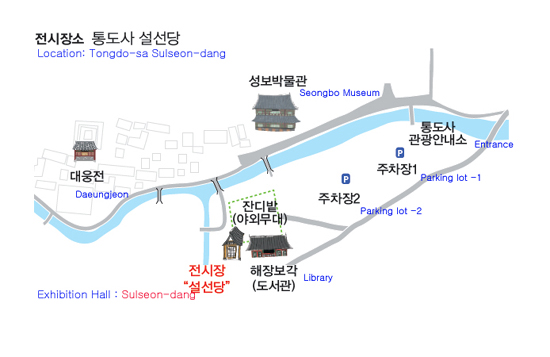Invited Solo Exhibition Tongdo-sa Yeongchuk Gaesan Daejae Cultural Celebration
Maehwa (Plum Tree) Blossoms - Circulation & Samsara
통도사(通度寺) 영축문화축제 개산대재 초대 개인전 - 매화 순환과 윤회
When : October 9~13, 2013
Where : Tongdo-sa Sulseon-dang
<626-861> Tongdosa-ro 108, Hakbuk-myeon, Yangsan-si, Gyeongsangnam-do, Korea
통도사 설선당(說禪堂) - 경남 양산시 하북면 통도사로 108번지
What : 26 paintings with Acrylic & Oil on linen
Contact : website www.tongdosa.or.kr Phone +82-55-382-1001
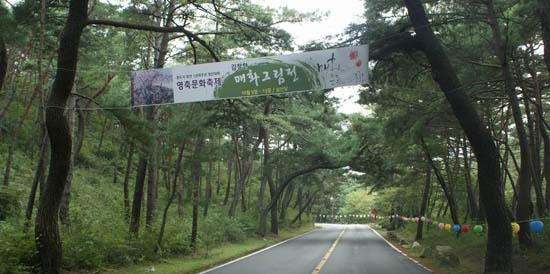
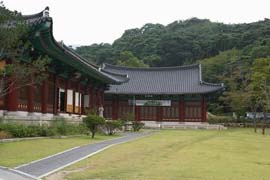


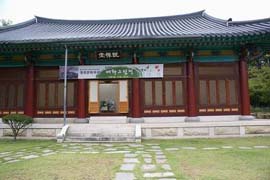
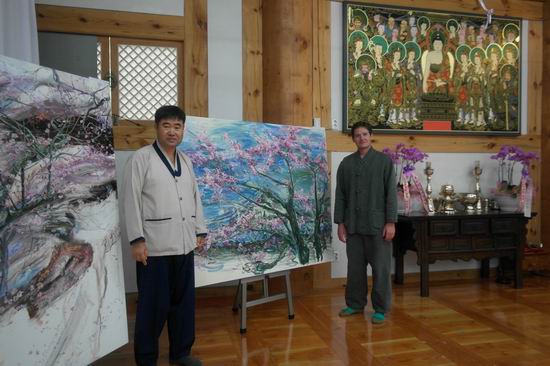
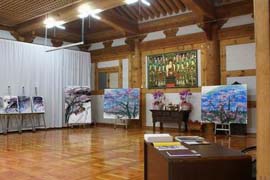
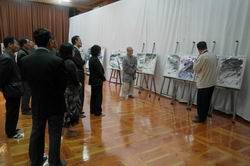
인사말씀
한국의 유서 깊은 삼보사찰 중 하나인 통도사 창건을 경축하는 개산문화대재 때 통도사 매화를 주제로 본인의 작품을 전시하게 되어 깊은 감사를 드립니다. 본인은 2003년부터 통도사 매화를 찾기 시작했고, 지금은 매년 봄이면 통도사를 시작으로 우리나라 각지의 고매(古梅)의 아름다움을 캔버스에 담고 있습니다.
금번 전시는 통도사 자장매(慈藏梅)를 중심으로 고매에 담긴 한국적 미의 원형과 아름다움을 현대적이며 독창적인 방식으로 표현함으로써, 매화를 통한 자연의 순환과 삶의 윤회에 대한 깊은 정신적 고찰(考察)을 보이고자 합니다. 전시작품은 지역별 매화나무(통도사 자장매, 화엄사 흑매(黑梅), 김해 와룡매(臥龍梅), 선암사 고매(古梅), 야매(野梅)...)와 매화꽃(백매, 홍매, 청매, 흑매)의 특성을 살려 풍부한 맛과 깊이를 나타내고자 했습니다.
금번 전시를 통해 한국 고매의 시각적인 아름다움뿐만 아니라 한국 전통문화에 대한 역사적/정신적 가치를 새롭게 볼 수 있는 계기가 된다면 더할 나위없는 영광이겠습니다.
감사합니다. 김창한
축사
매화전(梅花展)에 부쳐
지난 10여 년 간 봄보다 먼저 통도사를 찾아와 봄을 기다리는 화가가 있었다.
그가 화구를 열고 붓을 들 때 비로소 통도사의 봄이 열리고 세상 만물이 겨울잠에서 깨어났던 것이다.
통도사 역대 고승진영을 모신 전각 앞에 아주 오래된 홍매화 한그루가 있는데
혹자는 통도사를 중건하신 우운대사의 마음이라 하고
어떤 이는 개산조 자장율사의 세상을 향한 무언의 가르침이라고 하는데..
아무튼 아름다운 꽃은 두고두고 볼 일이다.
이번 가을에 그 꽃을 화가 김창한의 마음에서 옮겨와서 다시 피우려 한다.
참 고맙고 축할 할 일이다.
매화꽃이 있어 통도사의 봄이 봄다웠고 이 가을이 더욱 풍성할 것 같다.
영축총림 통도사 주지 원산 도명
Introduction
I would like to extend my deep gratitude for this opportunity to showcase one of Korea’s historically important locations - Tongdo-sa temple - to celebrate its establishment, which occurred during the Gaesan Daejae cultural celebration period.
In 2003, I personally initiated the practice of visiting Tongdo-sa to seek out the ancient Maehwa, which appear there on a yearly basis when spring commences. Painting at beautiful Tongdo-sa and elsewhere in the country, I endeavor every year to incorporate the essence of the Maehwa’s beauty on the canvas.
This exhibition carries the theme of Korea’s ancient paragon of beauty, coupled with beauty which correlates with modernity ? the old and the new, fused and expressed via a uniquely creative method. My approach with the Tongdo-sa Jajang Mae is to achieve a deep contemplative mode in expressing the natural cycle of life and to depict life’s miraculous perpetual motion.
Displayed are works featuring the Maehwa tree in various settings:
Tongdo-sa ? Jajang Mae; Hwaum-sa ? Heuk Mae (The Dark-red Mae); Gimhae ? Waryong Mae (The Lying Dragon Mae); Sunham-sa ? Goe Mae (The Ancient Mae); as well as the Ya Mae (The Wild Mae which blooms in deep mountains and fields). In rendering on canvas the plum blossoms of the flowering Maehwa, whether white, red, blue, or dark-red in color, I strive to bring forth their special ability to convey rich emotion, and to reveal deeply meaningful substance.
It is my hope that this exhibition will be conducive to re-envisioning the noble beauty of this tree. If I succeed in illuminating anew the historical and symbolic significance of this hallmark of Korea’s traditional culture, then the honor will be all mine.
Thank you very much.
Kim Chang Han
Greetings
About the exhibition of The Maehwa Works
During the last ten years, there has been an artist visiting Tongdo-sa earlier than the spring, and he has been eagerly anticipating the spring.
When he unfolds the canvas and takes up the paint brush in Tongdo-sa, only then does the spring of Tongdo-sa begin, all things in the world wakening from their long winter's sleep.
There is one particular very old Maehwa in front of the JeonGak where many noble monks’ portraits are enshrined. It is said that within this tree resides the heart of the Uun Daesa who rebuild the temple. I have also heard that the tree embodies the silent guidance toward the world of the Jajang Yulsa who established Tongdo-sa...The gorgeous blossoms of this Maehwa are worthy of long contemplation.
This coming fall, whoever wants to feel renewed, like the blossoms of spring, can take this feeling from the heart of the artist Kim Chang Han.This action shows true gratitude and is praiseworthy.
This spring at Tongdo-sa was most beautiful because of the Maehwa. Therefore, this coming fall will be incredibly rich.
The Abbot in Tongdo-sa Wonsan Domy

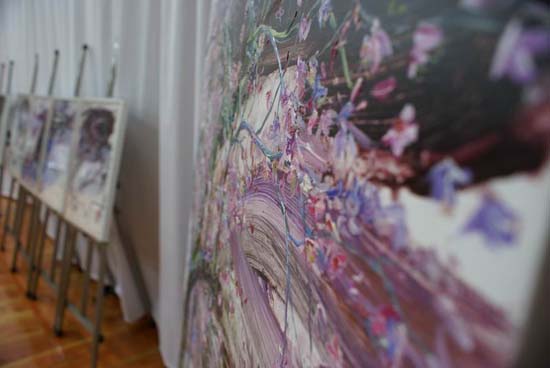
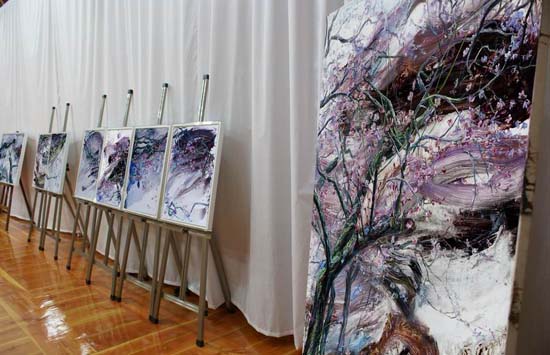
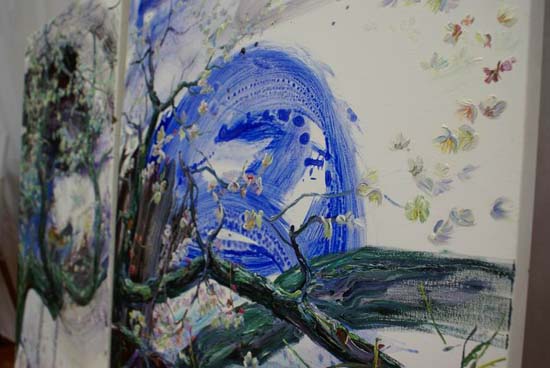
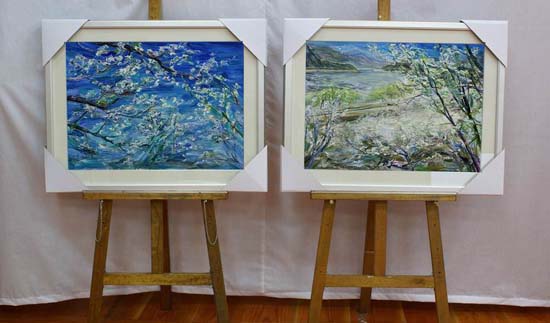
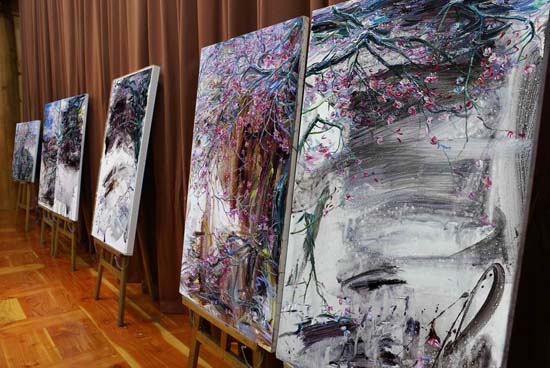
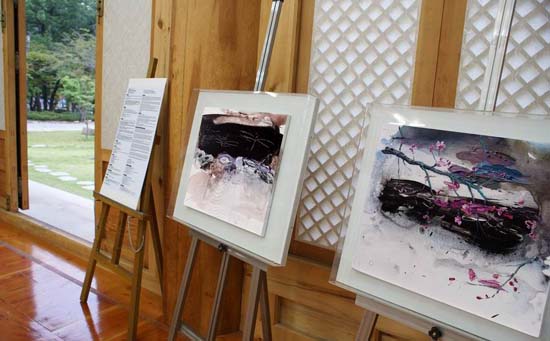
작품소개
본인의 매화 그림은 단순히 시각적인 아름다움뿐만 아니라 군자(君子)의 절제된 정신세계와 한국적 정서가 담겨있다.
늦겨울~초봄, 선홍빛으로 꿈틀거리는 홍매의 꽃망울이 하나 둘 터져 나올 때부터 하늘과 땅을 꽃잎으로 수놓을 때까지 순환(循環)하는 자연의 아름다움과 삶의 윤회(輪回)에 대한 경이로움, 그리고 찬란한 생명의 환희를 그렸다.
고매(古梅) 앞에서면 숙연한 마음과 가슴 뭉클한 전율을 느낀다.
고매 나무의 뒤틀어지면서도 절제되고 자유로운 형태와 나무둥치의 썩고 거친 모습과는 대조적으로 힘차게 쭉쭉 뻗은 가지에서 핀 형용할 수 없는 고운 꽃잎을 보면 험난한 삶의 여정을 견뎌온 아련한 고향의 봄 혹은 어머니의 사랑을 연상케 한다.
그리고 꿈속 같은 고매의 향연에 빠진다.
매화(梅花)작품은 대부분 오래된 사찰(寺刹)에서 그렸는데, 계절적 감각을 살리면서 현장감과 생동감을 강조했다. 작품은 매우 속도감 있게 완성한 것도 있고, 여러 해 동안 연속하여 그린 것도 많다. 즉 주제/대상에 대한 끊임없는 탐구를 통해 작품의 깊이를 더했다.
표현기법에서 작품의 배경이미지는 아크릴을 주로 사용하여 담백하면서도 풍부한 물맛과 추상적인 분위기를 강조했고, 매화 꽃/나무는 형상(形像)을 유지하면서 유채의 장점인 마띠에르 효과를 리드미컬하게 적절히 강조하면서 수채화처럼
싱그럽고 경쾌한 맛을 살렸다. 즉, 본인의 매화시리즈는 한국의 전통 수묵화와 서양화 표현재료의 장점을 조화시킨 현대적인 방식으로 표현했다.
‘잠자리의 사계(四季)’는 1990년부터 그렸는데, 2005년 ‘겨울잠자리’시리즈에서부터 매화와 잠자리를 같은 화면에 그리기 시작했다.
나는 잠자리를 통해 살아 숨쉬는 현대문명의 정제(精製)된 힘과 자연그대로의 건강한 삶과의 상징적 결합에 대해 관심이 많다.
잠자리의 구속되지 않은 자유로운 비행은 동심의 천진무구(天眞無垢)함 뿐만 아니라 인간의 정신과 육체의 자유로움을 메아리친다. 즉 나의 잠자리는 자연으로의 복귀와 자연적 삶에 대한 인간적 욕구를 불러일으킨다. 그곳에서 잠자리 연작은 계속된다. 이것은 인간의 제한된 굴레에서 벗어난 상상의 세계 혹은 신비스런 영적(靈的)인 정신세계이기도 하다. 화면의 여백은 무한한 상상의 공간이자 우주(宇宙)의 세계이기도 하다.
표현기법은 잠자리의 형태에서 일부 형상이 드러나기도 하지만 화면의 전체적인 분위기는 추상적 표현주의가 강조된다.
About “The Maehwa Works” & “Dragonfly Seasons”
My Maehwa paintings reach beyond the mere aesthetic beauty of the subject, bringing to bear symbolic meaning, especially in the realm of Korea’s emotional disposition: the noble character and strong discipline of the dedicated scholar.
It is easy to imagine the tree and its beautiful flowers as symbolic of struggle and life’s perpetual soldiering on. The act of blossoming is both gentle and forceful. The petal’s delicacy contrasts to gnarled boughs and rough twisted trunks. The Maehwa stretches toward the unreachable sky with an unyielding tenacity.
The Maehwa blossom season thrills me. This glorious spectacle fills me with a sobering appreciation. Often, I spend several minutes standing in front of the tree, contemplating its beauty and the emotion it stirs. In addition to the connotations of the soldier’s spirit, the Maehwa touches me personally, reminding me of my hometown in spring. I think of my mother's love when I look at the blossom’s inconceivably graceful form.
From late winter to early spring, the flower buds struggle to burst forth in profusion, until all of heaven and earth is embroidered with leaves and flower petals! The cyclical beauty of nature, the miraculous perpetual cycle of life, and splendid joy - all are present here.
The primary setting of The Maehwa Works, the grounds of aged Buddhist temples, nurtures the senses with the savor of the changing seasons, and infuses these paintings with a lively spirituality.
Some of these works were completed in one sitting, while many of them were created over several years. Returning every year afresh to the thematic connotations of the subject has added depth of meaning along with the layers of paint.
Acrylic paint has availed for the expressive technique of rendering the painting’s backdrop, the structural integrity of the Maehwa. Thus, the figure of the tree remains intact while the oil paints are applied. Taking full advantage of both mediums, the material effect is a rhythm with attributes of watercolor in that it is merry and refreshing. So, it can be said that The Maehwa Works enact a harmonious marriage of the positive traits of disparate materials: those traditionally utilized for the painting of a Korean SooMukhwa, and the more modern materials used in Western paintings, which require their own distinct methodology.
The dragonfly in flight is a natural image which I have been working with since 1990. My dragonflies have found expression in all seasons and many settings. Beginning with the Winter Dragonfly series of the year 2005, dragonflies and Maehwa have found their way onto the same canvas.
I am interested in the dragonfly as a symbol combining the refined power and activity of modern civilization with the raw, vivid life of nature.
The flight of the dragonfly echoes human mental and physical freedom as well as the whimsy of unfettered space. My dragonfly paintings strive to be boundless. They represent unlimited human imagination, and they delve into the mysteries of mental and spiritual space.
The blank space of the canvas is the universe as well as the freewheeling space of imagination.
I apply various methods in my Dragonfly Seasons series. In keeping with Expressionist techniques, the dragonfly’s form is sometimes only partially revealed, and these paintings generally assert Abstract Expression.
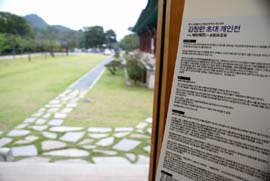
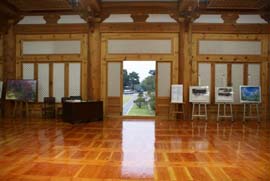
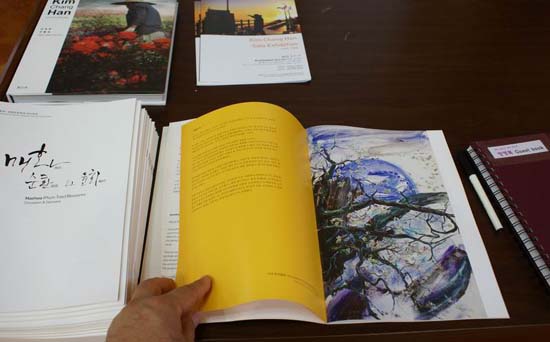
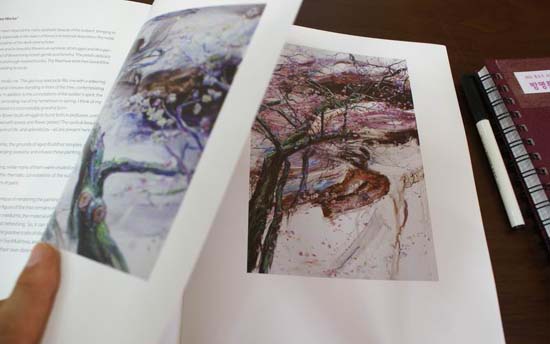
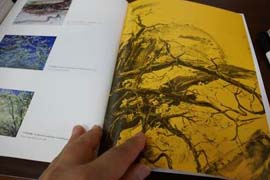

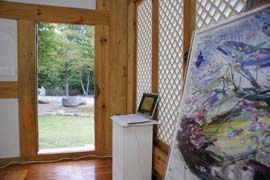
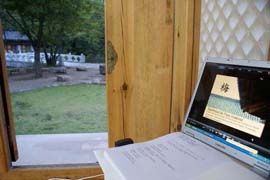
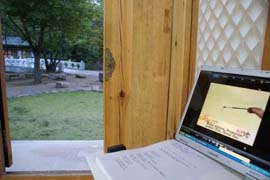
후기(後記)
혹자는 말하기를 세상은 아는 것만큼 눈에 들어온다고 했다.
2003년 봄, 처음 캔버스를 들고 통도사를 찾았을 때 눈에 들어왔던 것과 지금은 많은 변화가 있었다. 처음엔 단순히 홍매화의 황홀함에 빠졌던 것이 세월을 지나 매화에 담긴 내력과 매화가 품고 있는 장구한 세월의 이야기에 관심이 가기 시작했는데 앞으로 얼마나 더 그 깊이를 헤아릴 수 있을지...
통도사 자장매에 관한 내 작품의 글을 쓴다는 것은 쉬운 일이 아니었는데 이런 과정을 통해 더 많은 것을 깨닫는 것 같다. 그런데 이렇게 쓴 글을 영문으로 옮기는 과정에서 내가 쓴 글보다 더 내 작품에 담긴 뜻을 헤아려준 다니엘이 고맙게 와 닿았다. 어쩌면 그는 오랜 기간 한국에 머물면서 내 그림 속에 담긴 매화의 향을 나보다 더 깊이 느꼈을지도 모른다.
앞으로 우리의 전통매화에 담긴 깊고 그윽한 향기가 태평양을 건너 대서양을 건너 널리널리 퍼져나가길 기원해 본다.
그동안 통도사에서 매화를 그릴 수 있도록 도움을 주신 주지스님을 비롯한 사부대중께 깊은 감사를 드린다.
2013.9.13
김창한
Epilogue
It is said one knows oneself as much as one knows the world.
There is quite a difference between who I was on my first visit to Tongdo-sa in the spring of 2003 for painting and who I am these days. At first, I was just absorbed by the Maehwa's charming spectacle, and then as time passed, I became interested in the Maehwa's pedigree and the long history which surrounds the Maehwa. Who knows what I will grow to understand about the Maehwa’s depth in the future...
It has not been easy to write about my works centering on the Jajang Mae of Tongdo-sa, but I think that I have learned through this process. Most difficult has been translating into English. I have had editing help from my longtime American friend Daniel Julian, and I am very appreciative of his work, as I believe he has distinguished my meaning well, and I know he loves my art very much. Maybe he experiences my Maehwa painting's profound fragrance deeply like me.
I pray that our traditional Maehwa's deep fragrance reaches over the Pacific, the Atlantic and all over.
I really appreciate the people who have helped me to paint the Maehwa at the temple up to now, the Abbot and monks, who have helped me so much to have this exhibition.
September 13, 2013
Kim Chang Han
